Heterotrophic Nutrition – Types Of Heterotrophic Nutrition With Examples
Types Of Heterotrophic Nutrition
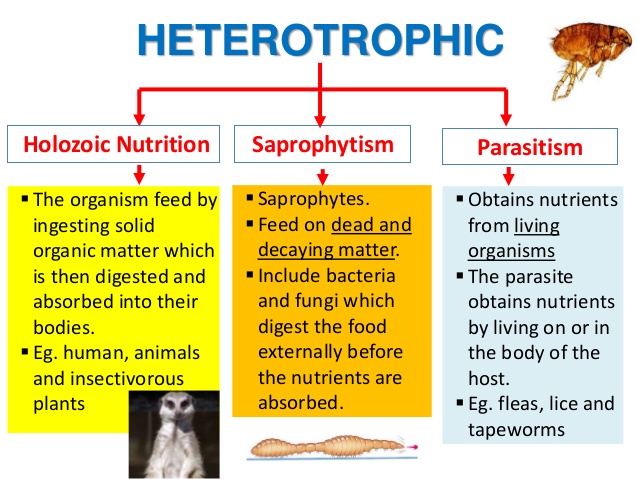
Heterotrophic Nutrition:
It is a mode of nutrition in which the organisms obtain readymade organic food from outside sources. The organisms that depend upon outside sources for obtaining organic nutritens are called heterotrophs. Heterotrophic nutrition is of three types – saprophytic, parasitic and holozoic.
- Saprophytic or Saprotrophic Nutrition:
It is a mode of heterotrophic nutrition in which food is obtained from organic remains like dead organisms, excreta, fallen leaves, broken twigs, food articles, etc. Organisms performing saprophytic nutrition are called saprophytes. - Parasitic Nutrition:
It is a mode of hetrotrophic nutrition in which a living organisms flourishes by obtaining food from another living organism. The lving organisms which obtains food and shelter from another organism is called parasite. The organism which provides food and shelter to a parasite is known as host. An external plant parasite is Cuscuta (Amarbel). It is a non-green plant that sends haustroria or sucking roots into host plant for obtaining food and water. - Holozoic Nutrition:
It is a mode of heterotrophic nutrition which involves intake of solid pieces of food. Since solid food is taken in, holozoic nutrition is also called ingestive nutrition. The food may consist of another animal, plant or its parts. Depending upon the source of food, holozoic organisms are of three types – Herbivores, carnivores, omnivores.
Herbivores:
(L.herba-plant, vorare-to eat). They are holozoic organisms which feed on plants or plant parts, e.g., Cow, Buffalo, Deer, Goat, Rabbit, Grasshopper, Elephant, Squirrel, Hippopotamus.
Carnivores:
They are animals which feed on other animals. Carnivores are also called predators they hunt, kill and feed on their preys, e.g. Lion, Tiger, Leopard, Snake, Hawk.
Omnivores:
(L.omnis-all, vorare-to eat). They are holozoic organisms which feed on both plant and animal materials, e.g. Cockroach, Ant, Pig, Crow, Rat, Bear, Dog, Humans.
Heterotrophic plants are of the following types:

Parasitic Plants
A parasitic plant is one that partially or completely depends on another plant (called host) for nutrition.
Usually, parasitic plants develop special roots, which penetrate into the tissues of the host plant. The prepared food is generally absorbed from the root or the stem of the host plant. Some examples are Cuscuta (dodder) and mistletoe.

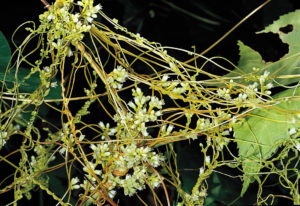
Mistletoe has leathery, green leaves, and so it can make its own food. But it depends on the host for minerals and water.
Cuscuta (Dodder) has a short root and a long, thread like stem. It twines around the host stem and sends branches around neighbouring stems.
In a parasitic relationship, only the parasitic plant benefits. The parasitic plant harms the host plant to some extent by slowing down its growth and sometimes causing heavy damage. However, a parasitic plant rarely kills the host plant.
Saprophytic Plants
A saprophytic plant is one that obtains its nutrients from dead and decaying plant and animal matter (sapros, rotting; phyton, plant). It is usually whitish, but some plants can have brightly coloured flowers. These plants often have no leaves at all. They often grow in deep shade in tropical forests. Some examples are Indian Pipe and coral root.
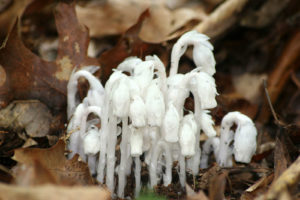
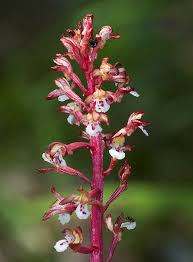
Indian Pipe is found commonly in Asia and North America. Coral roots are found in forests around the world.
The roots of saprophytic plants contain organisms called fungi. The fungi convert the dead and decaying matter into nutrients that can then be used as food like sugar by these plants. Fungi are also called saprotrophs.
Insectivorous Plants
Insectivorous plants are plants that derive some or most of their nutrients by trapping and consuming animals, mainly insects. These plants mostly grow in places where either the soil is deficient in certain nutrients (e.g., nitrogen) or too little light is available to carry out photosynthesis.
Hence, these plants need to obtain the required nutrients from other sources. Some examples are the pitcher plant, Drosera (sundew), bladderwort, and the Venus flytrap.
The leaf of the pitcher plant is modified to form a tubular pitcher-like structure. The inside of the pitcher is lined with downward pointing hair that do not allow any trapped insect to climb up and escape. The fluid at the bottom of the pitcher contains digestive juices that digest the insect.
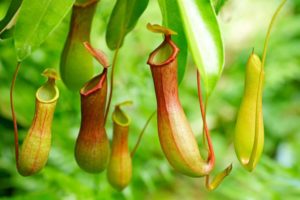
The slender leaves of bladderworts bear a large number of very small, pear-shaped bladder structures, which act like trapdoors and suck in small insects in less than a second.
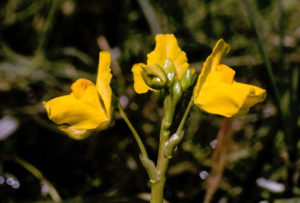
The leaves of the sundew plant have long, thin structures called tentacles, which have drops of a sticky substance called mucilage at their ends. Once an insect touches the tentacles, it gets stuck in the mucilage and is unable to escape. It is then digested.
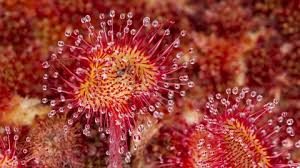
The Venus flytrap has leaves that are modified to trap insects. The inner surface of the leaves have short, stiff hair. When an insect touches the hair, the leaves snap shut in less than a second. The insect is then digested.

Symbiotic Plants
Certain plants live in association with other organisms, share food and other resources. Both the types mutually gain from each other. Such plants are called symbiotic plants and the relationship is called symbiotic. A good example is lichens.

Activity
Aim: To grow fungi.
Materials required: A piece of bread, water, and box.
Method:
Moisten the bread with water and keep it in the closed box for a few days.
Observation: You will see some grey patches on the bread.
Conclusion: The patches are due to the growth of fungi.